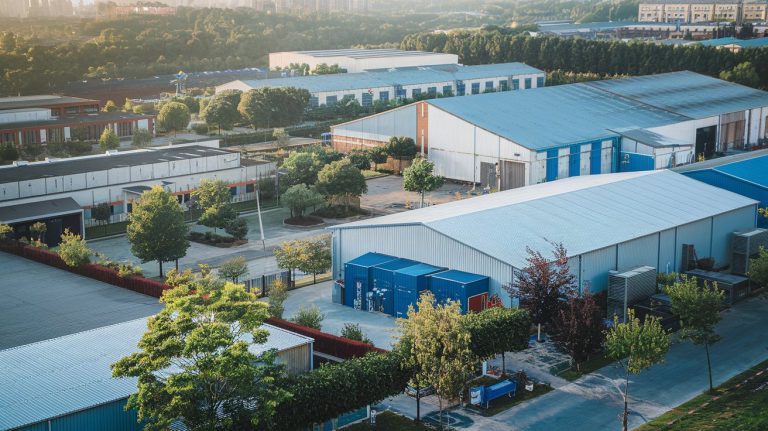Industrial parks are no longer just hubs of manufacturing and production; they have evolved into vital ecosystems for fostering sustainable growth. These parks are pivotal in driving the circular economy, where resources are reused, recycled, and restored, creating a sustainable industrial framework.
Among the pioneers in this movement, Magna Star Industrial & Logistics Park stands out as a leader in promoting eco-conscious development and enabling businesses to thrive in harmony with nature.
Let’s explore how business parks are reshaping industries through the circular economy.
1. Shared Resources for Green Businesses
Industrial parks provide a fertile ground for environment-conscious businesses, encouraging shared resources and services that reduce waste. By co-locating enterprises with complementary operations, these parks enable companies to share utilities like water, energy, and transportation systems. This integrated approach minimizes resource consumption while maximizing efficiency.
For instance, Magna Star’s infrastructure allows startups and established businesses to set up operations seamlessly. With ready-to-use facilities and shared utilities, businesses can focus on innovating sustainable solutions rather than logistical challenges.
Moreover, industrial parks foster a culture of innovation, particularly among green businesses, by promoting collaboration between land owners. This collaborative spirit drives the development of products and services that align with circular economy principles.
2. Waste Management and Recycling Systems

Waste is a key concern for industrial operations, and industrial parks like Magna Star are tackling this challenge head-on. These parks implement centralized waste management systems that facilitate recycling and reuse of materials.
In many cases, waste from one company becomes a resource for another.
For example, by-products from manufacturing processes can be repurposed into raw materials for other businesses within the park, supporting the principles of the circular economy. Such synergies reduce landfill dependency and promote resource optimization.
This strategy not only benefits the environment but also attracts green businesses that prioritize sustainable practices.
3. Attracting Green Investments
Logistics parks are also transforming how people view land investment. Traditionally seen as a static asset, investing in industrial plots offers dynamic opportunities. These parks are designed with long-term environmental goals, making them attractive to investors who want to invest in their business growth and brand visibility while aligning with global sustainability trends.
With governments and private players advocating for eco-friendly initiatives, industrial parks are increasingly becoming ideal hubs for eco-friendly businesses.
For investors, this means high-value returns, especially as the demand for sustainable spaces continues to grow.
4. Enhancing Job Opportunities

Sustainability and economic growth go hand in hand in industrial parks. By nurturing circular economy principles, these parks create numerous job opportunities across various sectors.
Magna Star has positioned itself as a centre for innovation, attracting professionals in renewable energy, waste management, and green technology. It also supports MSMEs, which in turn provide employment opportunities for local businesses, local artisans, and local communities.
The development of green businesses and eco-friendly infrastructure in these parks also paves the way for skilled and semi-skilled jobs. From designing energy-efficient systems to managing recycling processes, industrial parks ensure that sustainability-driven industries, grounded in circular economy principles, have a steady talent pool.
In addition to direct employment, such parks indirectly boost job opportunities by supporting local suppliers and service providers. This cascading effect strengthens regional economies and promotes inclusive growth.
5. Plug and Play Facilities for Rapid Growth
The circular economy thrives on agility and adaptability, both of which are supported by plug-and-play infrastructure. Industrial parks offer ready-to-use facilities that drastically reduce setup time for businesses. This is especially beneficial for green businesses, which can quickly establish operations without the hassle of building from scratch.
Plug-and-play facilities also reduce resource wastage during the construction phase. Since the infrastructure is pre-designed and standardized, businesses can avoid excess material usage and unnecessary delays.
This model not only encourages companies to adopt sustainable practices but also attracts investors looking to invest in land that aligns with future-ready development trends.
6. Driving Innovation through Collaboration
Collaboration is at the heart of the circular economy, and industrial parks act as innovation hubs for diverse industries. Magna Star’s ecosystem, as such, brings together companies, researchers, and policymakers to develop cutting-edge solutions.
By fostering such synergies, these parks ensure that ideas are not only generated but also implemented effectively. This culture of innovation attracts forward-thinking businesses and investors who are eager to invest in industrial plots with long-term potential.
The close proximity of businesses in business parks facilitates the exchange of knowledge and resources, leading to breakthroughs in sustainability. These innovations often create ripple effects, inspiring other industries to adopt circular practices.
7. Boosting Economic Growth and Sustainability

Industrial parks are not just engines of industrialization; they are catalysts for sustainable economic growth. By integrating circular economy principles, parks like Magna Star prove that profitability and environmental stewardship can coexist.
This balance appeals to investors seeking opportunities to invest in land with sustainable development prospects. Additionally, as the demand for eco-friendly products and services grows, the value of industrial plots within such parks is likely to appreciate, offering lucrative returns for investors.
Furthermore, the creation of job opportunities in these parks ensures that economic benefits are shared widely, contributing to social and environmental well-being.
The Circular Economy and Industrial Parks: A Natural Partnership
Industrial parks play a crucial role in driving the circular economy. By promoting resource efficiency, reducing waste, and fostering innovation, they create a blueprint for sustainable industrialization. Magna Star exemplifies this vision, offering a platform for green businesses, lucrative land investment opportunities, and the creation of meaningful job opportunities.
As the world moves toward a greener future, investing in industrial parks like Magna Star is not just a smart choice—it’s a step toward building a better planet.


